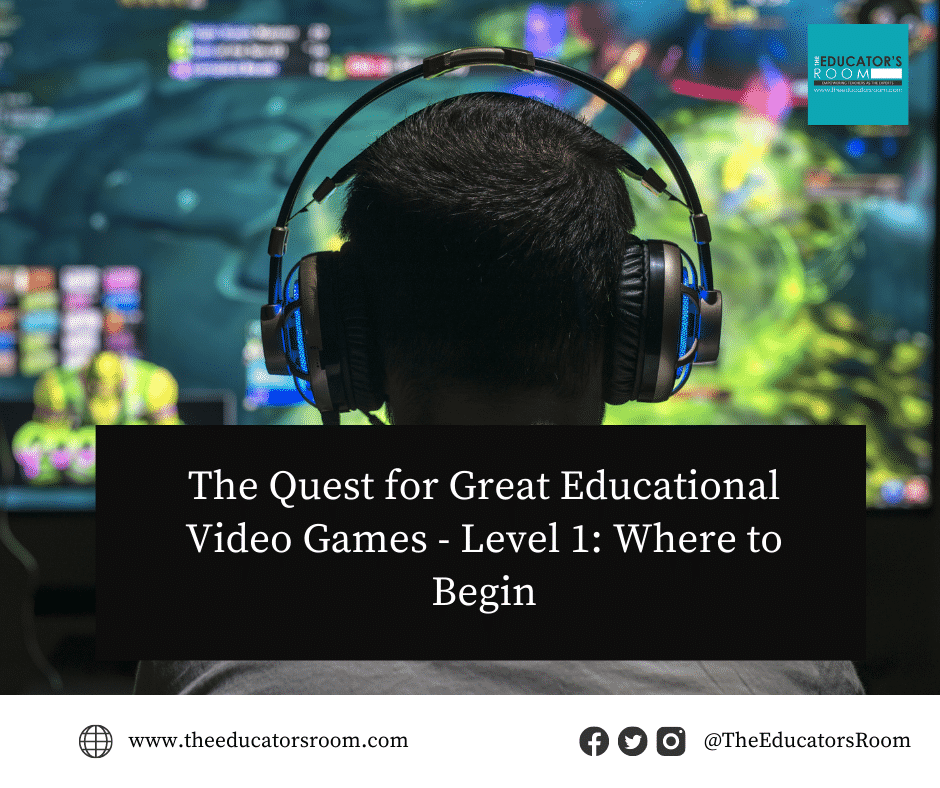Educational Video Games (henceforth eduGames) are as old as video games themselves, but their respective paths have led to completely different destinations.
From Pong to Fortnite, commercial video games went from an at-home experience to a legitimate organized sport. They continue to be one of the most popular items in the entertainment market. Many eGaming champions have even earned handsome prizes in the millions. Lately, video games have demanded more respect than ever.
Meanwhile, eduGames–the path less traveled–have struggled for decades to gain any sort of legitimacy. Some are more successful than others, but none of their titles ring the same bells as the Super Marios, Halos, or Zeldas. Though eduGames aim to enlighten those who play them, they live deep in the shadows of commercial video games.
The biggest problem eduGames faces, as made clear by Czauderna and Guardiola, is the difficulty of achieving both entertaining and educational qualities. They state:
“…educational games should be as appealing as commercial, off-the-shelf games designed solely for entertainment, and they should provide their players with a learning experience related to educational domains beyond the game itself.”
Academic games consistently fail without ever truly accomplishing this combination. Since commercial games must entertain to be popular, there is no pressure to accomplish any kind of learning experience. Meanwhile, eduGame developers continue to search for this elusive harmony between enjoyment and enrichment.
Take the original EduGame console: VTech Socrates. Dubbed as a form of “edutainment,” the appearance alone reveals itself as an educational tool. No kid is going to look at that and get excited. When they see a full keyboard and a minimal calculator on this so-called “game controller,” they’ll let out the same sigh as when instructed to fetch their textbooks.
EduGames, edutainment, or whatever else it is known as, needs a serious upgrade.
Getting with the Times
Children dictate a large part of the market. Advertisements are often groomed for young audiences because companies are aware of where a parent’s money is going, much of that spending going towards video games.
In a similar vein but a different tone, children are also the reason for schools–but their interests carry much less influence in this matter. Santa Claus isn’t popular for bringing protractors and bookmarks. Education, unlike video games, continues to fail in becoming something relevant that children can find a reason to become involved in.
I’m frequently asking my students, like many teachers, what they want to be when they grow up. Their answers: YouTuber or eGamer. These are, bar none, the most popular two answers today. These are the interests of today’s learners. The amount of time they commit to either medium is astronomical. We must consider this in our pedagogical pursuits to capitalize on some of this invested time.
What chances are we willing to take to revolutionize education? David McCall, creator of Schoolhouse Rock, came up with his ingenious idea by paying attention to what his son cared about. As it went, Christian Buckler reports, “He heard his son singing along with song after song on the radio, even though the same child struggled to remember basic multiplication rules.” McCall found an avenue yet to be explored between the universal joy of music and mundane learning concepts. An unrivaled feat in education.
Yet, to say eduGames need to be more fun is an understatement. The industry needs a complete overhaul–maybe even a disguise.
Bearing the Title “Educational”
An association with education–for anything–is enough for modern-day kids to seek out distractions immediately. It’s an associative death wish for anything entertaining. We need to rethink our approach.
Our intentions, as righteous as they may be, cannot be shared on the surface. These efforts must be made subliminal. The stigma of the title “educational” is too off-putting.
Take the word cartoons. Kids love them. Now place “educational” in front of it. Past a young age, the admiration for them drastically declines.
We must make it so they don’t even know they are learning, just playing games. The learning aspects become a part of the mechanics of the game and allow skills to develop naturally. There are many components of popular games that can be translated into educational tools.
To do this, forces must unite–educators with game developers, teachers with gamers–all aiming to find that elusive power: enriching entertainment.
Identifying the Problem
What we need is another groundbreaking form of edutainment–something as successful as Schoolhouse Rock. The directional focus of eduGaming development, however, is just not there. Few people can agree on what direction to take, let alone an understanding of how it fits into education long-term.
Douglas Clark, PhD, professor at Vanderbilt University, shares his wisdom on this matter:
“In recent years, there’s been this emphasis on whether games are better than traditional instruction, but that’s not really a helpful distinction because it’s not an either-or concept,” says Clark. “The research shows that games as a medium can be effective, but not always. Design is really what matters. Nobody assumes that all lectures, labs or books are good simply because of their medium.”
Like every other branch of education, it comes down to dedicated educators and proper funding. The desire for, and potential of, high-functioning eduGames has existed for decades. With the right combination of ambition, planning, and follow-through, a successful eduGame can come to life.
The best eduGames of today (Gimkit, Minecraft, The Oregon Trail, etc.) stand tall above the rest in classrooms–and in students’ hearts–but only garner so much interest or participation outside of what is required (with the exception of Minecraft). They have found some of their own video game magic but nothing like the wizardry of Nintendo, Playstation, XBox, and Steam.
But to say the problem is as simple as an expensive tune-up would be an insult to eduGame developers and curriculum designers everywhere.
Only the Beginning
We know games must be both educational and entertaining. We know playing on pre-existing interests in children makes for an easier sell. We know that identifying as “educational” has its deficits. And, finally, we know we must strive for inventive methods that rival commercial video games if eduGames ever want to truly compete.
Czauderna and Guardiola, quoted earlier, have taken this knowledge into consideration and determined the best possible game design to accomplish all these barriers. Their conclusion pointed them to a style known as the Gameplay Loop Design, which, fortunately for eduGame developers, happens to be the most popular style of game design.
Super Mario, Call of Duty, Clash of Clans, and Pokemon all use this popular game design. The Gameplay Loop revolutionized video gaming, and it can do the same thing for eduGames.
In fact, it isn’t far from the style of rote memorization, an already common practice in education. Learn, test, repeat, until mastery is achieved. Same goes for traditional games. Learn a skill. Test it on the world. Repeat the skill until you’ve mastered the world.
So, with these observations in mind, my quest for great educational video games can begin.
“Every age has its storytelling form, and video gaming is a huge part of our culture. You can ignore or embrace video games and imbue them with the best artistic quality. People are enthralled with video games in the same way as other people love the cinema or theatre.”
-Andy Serkis
On the Next Quest:
Level 2: Modeling eduGames on Mainstream Video Games







